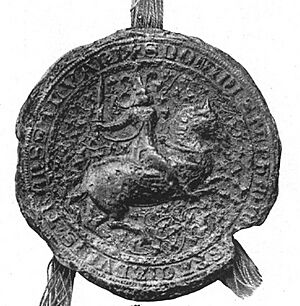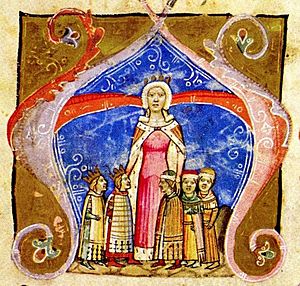Stephen of Anjou facts for kids
Quick facts for kids Stephen |
|
|---|---|
| Duke of Transylvania, Croatia, Dalmatia and Slavonia | |

Seal of Stephen of Anjou, 1351
|
|
| Born | 20 August 1332 |
| Died | 9 August 1354 (aged 21) |
| Burial | Zagreb Cathedral (?) |
| Spouse | Margaret of Bavaria |
| Issue | John, Duke of Slavonia Elizabeth, Princess of Taranto |
| House | Capetian House of Anjou |
| Father | Charles I of Hungary |
| Mother | Elizabeth of Poland |
Stephen (Hungarian: István) was a Hungarian prince who lived from 1332 to 1354. He was part of the Capetian House of Anjou, a very important royal family. Stephen was the youngest son of Charles I of Hungary, who was the King of Hungary, and Elizabeth of Poland.
Stephen was called the duke of Slavonia from 1339 to 1346. However, he did not actually rule this area himself. Later, in 1349, he got his own royal household. His brother, Louis I of Hungary, gave him control over the areas of Szepes and Sáros. Louis also made him the duke of Transylvania in late 1349. Soon after, Stephen was put in charge of Slavonia.
Many people thought Stephen would become king because his brother Louis had no children. Stephen and his mother even helped rule the kingdom in 1350. This was when Louis was away fighting in Naples. Stephen was again made duke of Transylvania later that year. From 1352 to 1353, he was known as the duke of Szepes and Sáros. After that, he was given the job of managing Croatia, Dalmatia, and Slavonia. Stephen died in 1354 while returning from a military campaign against Serbia. His young son, John, inherited his title.
Contents
Early Life and Royal Duties
Stephen was the youngest of five sons born to King Charles I and Queen Elizabeth. Only three of their sons, Louis, Andrew, and Stephen, lived past childhood. Stephen was born on August 20, 1332. He was named after Stephen, the very first king of Hungary. A priest named Ladislaus helped teach him.

Stephen was first mentioned in a royal document from his father in 1339. This document called him the Duke of Slavonia. But he did not directly govern the region. Instead, local governors, called bans, continued to rule Slavonia for the king. In 1339, Stephen's uncle, Casimir III of Poland, said that Stephen's parents or one of their sons would be his heir if he died without children. Some historians later thought King Charles wanted Stephen to be his heir in Hungary.
King Charles I died on July 16, 1342. For the first few years of his brother Louis's rule, Stephen was not mentioned much in official papers. By May 1345, Stephen was regularly mentioned in his brother's documents. This showed that he had become a member of the king's important council.
Family Troubles and Campaigns
Stephen's brother, Andrew, was married to Joanna I of Naples. Andrew was sadly murdered in 1345. Louis I of Hungary believed Joanna was involved in the plot. Louis wrote to Pope Clement VI, asking for Joanna to be punished. From 1346, Louis also asked the Pope to give the Kingdom of Naples to him or to Stephen. The Pope sometimes called Stephen the duke of Transylvania in his letters. However, Hungarian documents still called him the "duke of all Slavonia" in 1345 and 1346. Louis took over many areas during his first military campaign in southern Italy. But after he went back to Hungary, Joanna and her new husband took back most of the castles.
Becoming a Duke
Stephen was given his own royal household in the summer of 1349. He also received control over the counties of Szepes and Sáros. This move was likely connected to talks between his brother Louis and a special church representative. Louis I suggested that Stephen should marry Maria, who was Joanna I's sister and heir. Louis also wanted the Pope to give Naples to Stephen.
Stephen called himself "lord of Szepes and Sáros" in his documents from 1349. In November of that year, he also used the title "duke of Transylvania." Stephen's time as duke of Transylvania was short. He was soon appointed to manage Slavonia.
Stephen was already seen as the heir to Louis, who had no children. Before Louis left for his second military campaign in Naples in 1350, he made Stephen and their mother his main representatives. Stephen was again made duke of Transylvania in late 1350. He visited Transylvania in January 1351. He used the title duke of Transylvania for the last time in October 1351.
Stephen then governed Szepes and Sáros again from late 1351 to early 1353. After that, Louis I put him in charge of Croatia, Dalmatia, and Slavonia. This was probably because Hungary's relationship with nearby countries like Venice and Serbia was becoming difficult. Stephen died on August 9, 1354, for reasons that are not fully known. He passed away while returning from a military campaign against Serbia. Local stories say he was buried in the Zagreb Cathedral.
Family Life
| Ancestors of Stephen of Anjou | ||||||||||||||||||||||||||||||||||||||||||||||||||||||||||||||||||||||||||||||||||||||||||||||||||||||||||||||||||||||||||||||||||||||||||||||||||||||||||||||||||||||||||||||||||||||||||||||||||||||||||||||||||||||||||||||||||||||||||||||||||||||||||||||||||||||||||||||||||||||||||||||||||||||||||||||||||||||||||||||||||||||||||||||||||||||||||||||||||||||||||||||||||||||||||||||||||||||||||||||||||||||||||||||||||||||||||||||||||||||||||||||||||||||||||||||||||||||||||||||||||||||||||||||||||||||||||||||||||||||||||||||||||||||||||||||||||||||||||||||||||||||||||||||||||||||||||||||||
|---|---|---|---|---|---|---|---|---|---|---|---|---|---|---|---|---|---|---|---|---|---|---|---|---|---|---|---|---|---|---|---|---|---|---|---|---|---|---|---|---|---|---|---|---|---|---|---|---|---|---|---|---|---|---|---|---|---|---|---|---|---|---|---|---|---|---|---|---|---|---|---|---|---|---|---|---|---|---|---|---|---|---|---|---|---|---|---|---|---|---|---|---|---|---|---|---|---|---|---|---|---|---|---|---|---|---|---|---|---|---|---|---|---|---|---|---|---|---|---|---|---|---|---|---|---|---|---|---|---|---|---|---|---|---|---|---|---|---|---|---|---|---|---|---|---|---|---|---|---|---|---|---|---|---|---|---|---|---|---|---|---|---|---|---|---|---|---|---|---|---|---|---|---|---|---|---|---|---|---|---|---|---|---|---|---|---|---|---|---|---|---|---|---|---|---|---|---|---|---|---|---|---|---|---|---|---|---|---|---|---|---|---|---|---|---|---|---|---|---|---|---|---|---|---|---|---|---|---|---|---|---|---|---|---|---|---|---|---|---|---|---|---|---|---|---|---|---|---|---|---|---|---|---|---|---|---|---|---|---|---|---|---|---|---|---|---|---|---|---|---|---|---|---|---|---|---|---|---|---|---|---|---|---|---|---|---|---|---|---|---|---|---|---|---|---|---|---|---|---|---|---|---|---|---|---|---|---|---|---|---|---|---|---|---|---|---|---|---|---|---|---|---|---|---|---|---|---|---|---|---|---|---|---|---|---|---|---|---|---|---|---|---|---|---|---|---|---|---|---|---|---|---|---|---|---|---|---|---|---|---|---|---|---|---|---|---|---|---|---|---|---|---|---|---|---|---|---|---|---|---|---|---|---|---|---|---|---|---|---|---|---|---|---|---|---|---|---|---|---|---|---|---|---|---|---|---|---|---|---|---|---|---|---|---|---|---|---|---|---|---|---|---|---|---|---|---|---|---|---|---|---|---|---|---|---|---|---|---|---|---|---|---|---|---|---|---|---|---|---|---|---|---|---|---|---|---|---|---|---|---|---|---|---|---|---|---|---|---|---|---|---|---|---|---|---|---|---|---|---|---|---|---|---|---|---|---|---|---|---|---|---|---|---|---|---|---|---|---|---|---|---|---|---|---|---|---|---|---|---|---|---|---|---|---|---|---|---|---|---|---|---|---|---|---|---|---|---|---|---|---|---|---|---|---|---|---|---|---|---|---|---|---|---|---|---|---|---|---|---|---|---|---|---|---|---|---|---|---|---|---|---|---|---|---|---|---|---|---|---|---|---|---|---|---|---|---|---|---|---|---|---|---|---|---|---|---|---|---|---|---|---|---|
|
||||||||||||||||||||||||||||||||||||||||||||||||||||||||||||||||||||||||||||||||||||||||||||||||||||||||||||||||||||||||||||||||||||||||||||||||||||||||||||||||||||||||||||||||||||||||||||||||||||||||||||||||||||||||||||||||||||||||||||||||||||||||||||||||||||||||||||||||||||||||||||||||||||||||||||||||||||||||||||||||||||||||||||||||||||||||||||||||||||||||||||||||||||||||||||||||||||||||||||||||||||||||||||||||||||||||||||||||||||||||||||||||||||||||||||||||||||||||||||||||||||||||||||||||||||||||||||||||||||||||||||||||||||||||||||||||||||||||||||||||||||||||||||||||||||||||||||||||
Plans for Stephen to marry Margaret of Bavaria were first talked about in 1345. Margaret was the daughter of the Holy Roman Emperor, Louis IV. The Pope had disagreed with Louis IV, which made things complicated. Stephen married Margaret in late 1350, after her father had died. This was because Pope Clement VI had strongly opposed the marriage before.
Stephen's marriage to a German princess made him less popular in Poland. In 1351, Polish noblemen agreed that Louis would be the only heir to Casimir III. But only after Louis promised that Stephen would not be involved in ruling Poland.
Stephen and Margaret had two children: a daughter and a son. Their daughter, Elizabeth, was born around 1353. She later married Philip of Taranto in 1370. Stephen's son, John, inherited his father's titles. He became the Duke of Croatia, Dalmatia, and Slavonia. However, John was still a child when he died in 1360.
See also
 In Spanish: Esteban de Anjou para niños
In Spanish: Esteban de Anjou para niños
- Stephen's Tower (Budapest)

